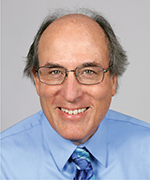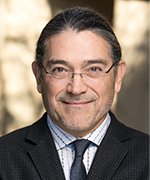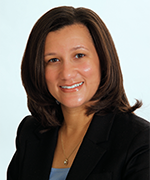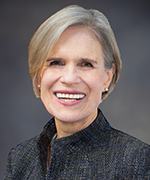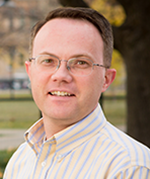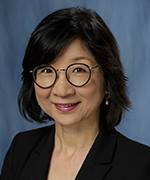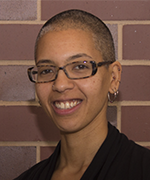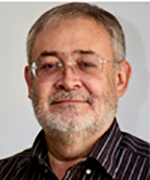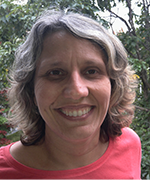2020 ASA Board of Directors Candidates
The ASA announces the selection of candidates for the 2019 election. The winning candidates’ terms will begin in 2020. Make sure to look for your ballots in your email inbox and vote early. Voting begins at 12:01 a.m. ET March 15 and ends at 11:59 p.m. PT on May 1.
Quick Links
Navigate to each race via the following links:
Running for President-Elect
Running for Vice President
Running for Council of Chapters Representative to the Board
Running for Council of Sections Representative to the Board
Running for International Representative to the Board
List of Candidates
Running for President-Elect 2020
David A. Marker
Senior Statistician and Associate Director, Westat
What a wonderful time it is to be a statistician. Every day, I feel inspired hearing about decisions being made based on data; I’m sure you feel similarly. Unfortunately, we know that often these decisions do not properly account for the presence of uncertainty in the data or they completely exclude data that do not conform to the user’s expectations. We know that all decisions have uncertainty, but we can’t let that lead to inaction. Statistician’s capabilities and data-based decision-making can have powerful and influential results.
My work as an expert witness before federal and state courts on voter ID laws—and in Canadian provincial court on language-minority rights—provided an opportunity to demonstrate the important role statistics can play in advancing human rights. Testifying before Congress, I conveyed the accuracy of data we collected on homelessness to encourage its use in policy-making.
The ASA’s Strategic Plan vision statement is “A world that relies on data and statistical thinking to drive discovery and inform decisions.” This only happens if decision-makers and regular citizens understand how to act in the presence of uncertainty. Our goal should be to move forward with efforts to increase willingness to make such decisions. All segments of the ASA can be involved in such efforts.
The ASA Board of Directors has issued a number of important statements consistent with this goal, from proper use of p-values to the role of statistics in climate change; we need to continue these efforts. We should encourage our journals to allow for pre-registration of analyses to strengthen the reliability of our findings.
Chapters have a large role to play. As chapter’s representative to the ASA Board, I learned about many vibrant chapter programs. We must continue to support the development of programming that is relevant to acting in the presence of uncertainty and ensure these programs are replicated.
As chair of the ASA’s Scientific and Public Affairs Advisory Committee, I organized the ASA Workshop on a Statistical Consensus on Climate Change. We brought together academics, industry, and government statisticians to identify how our profession could increase its role in advancing science through better use of statistics. The ASA Advisory Committee on Climate Change Policy continues this important work. Partnerships with the AAAS and other scientific communities are essential to expanding the breadth of topics where statistical knowledge is brought to bear.
The ASA can help educators, whether K–12 or at colleges and universities, communicate “that statistics is the science of learning from data and of measuring, controlling, and communicating uncertainty.” Current events provide many examples that can be used to make statistics relevant to students, who will become our future ASA members. Continued outreach to educators (e.g., providing a database of examples through our K–12 Statistical Ambassador) is an essential building block to expand the impact of statistics.
To be most successful, we need to grow our organization. Statistical and data science jobs are growing rapidly; statistical degrees, especially at the bachelor’s level, are also growing. By encouraging many of these people to join the ASA, the power of our voice will be expanded.
The current push to expand voting rights in this country includes automatic voter registration, whereby citizens are added to voter rolls unless they decline the opportunity. The ASA should establish a similar program, where every student who graduates with a degree in statistics/biostatistics/data science automatically becomes an ASA member for free. By the time they switch from free to dues-paying, we can demonstrate the advantages of membership.
We should reach out to large employers—including Google, Facebook, and the pharma industry—to encourage their participation.
The ASA, while international in both membership and ethnic backgrounds, has more to do to be welcoming to all. Recent presidential initiatives have encouraged people of all backgrounds to become leaders within the ASA; we can expand on this. We should continue to recruit students of minority backgrounds to ensure representation of our country’s diversity. Local chapters could reach out to historically black colleges and other institutions to share opportunities to positively impact society by being a statistician.
I am deeply honored to be a candidate for president of the ASA. Having represented chapters, sections, and committees of the ASA in the past, I look forward to the opportunity to work with all ASA members to promote the practice and profession of statistics.
Robert L. Santos
Vice President and Chief Methodologist, Urban Institute
I’m just a kid (albeit much older) from a San Antonio barrio with two career passions: statistics and helping people. I like adventure, too, so, over the years, I took some chances and here I am, ready to help you.
I think big and creatively, offering half-crazy ideas to provoke thoughtful deliberation. I value teamwork above individualism because I find it typically yields richer results. Parts of my career were as an isolated statistician; it allowed me to focus on and value ASA membership. I’ve worked hard at increasing ASA member diversity and helping us understand its immense value to our profession. I’ve found a home in public policy research, consulting, mentoring, and working on teams to improve our society.
As potential ASA president, I offer the following for your consideration:
Strategic reflection. The ASA offers a big tent, but we yearn to attract and retain young professionals, as well as students not just from statistics departments. In a global and digital world, let’s reconsider what an association should be in contemporary society. In turn, this will motivate who our member base is and what ASA membership means, thus reinforcing our cultural relevance. I will work with you to develop this vision.
Building community from sections. The ASA has sections, many devoted to a specific statistical application. I would promote synergies by fostering cross-section activities so that members learn from each other. This could be through special invited sessions, workshops, hackathons, or other more engaging activities at JSM, CSP, or chapter events. We have an opportunity to cross-fertilize, and this will build a stronger sense of community.
Increasing support of member-based work. The ASA enjoys a broad membership across many disciplines. Membership strengths lie in increasing diversity, global reach, and expanding areas of application. As a board member, I witnessed firsthand the leadership of our sections, chapters, committees, and caucuses. As president, I’d advocate for additional support to committees, sections, and chapters, including a broad-ranging assessment to identify scalable initiatives and programs (best practices) that might otherwise slide off our radar.
Adding critical thinking. Statisticians often work in teams and can be the wise adviser via critical thinking. It’s irresponsible to just crank out a sample size, model, or p-value on demand. The ASA offers related programs in leadership, communications, etc., plus CSP short courses. I’d canvass these to create a pilot training focusing specifically on the role of critical thinking for statisticians in project teams.
As a leader, I’ve devoted much of my career to serving the statistical community, serving on both the ASA and WSS [Washington Statistical Society] Board of Directors. I held numerous committee and section officer positions since joining in 1977, receiving ASA Fellow and Founder’s awards. I’ve served as president of a sister organization, AAPOR. I’ve worked in academic and commercial research organizations and heavily participated in government service (e.g., study sections, federal committees, NAS panels); I serve on the NCHS Board of Scientific Counselors. I understand the myriad perspectives and diverse backgrounds of our members.
As an executive officer, I embrace stewardship and decision-making motivated by values, mission, and fidelity to strategic plan. I make tough decisions as needed, but with compassion. It would be the honor of a lifetime to serve you. It would be a labor of love and service with humility.
Want to know more? Check out my candidacy website.
Running for Vice President 2020–2022
Dionne L. Price
Director, Division of Biometrics IV, Office of Biostatistics, Office of Translational Sciences, Center for Drug Evaluation and Research, Food and Drug Administration
As a statistician at the Center for Drug Evaluation and Research of the Food and Drug Administration (FDA), I have witnessed the changing landscape of drug development over the years. With this evolution has come a vast number of opportunities and challenges for statisticians. I propose that this phenomenon is not unique to FDA and that the statistics profession is also experiencing an evolution. While the foundation of statistics remains unchanged, the practice and application of statistics has grown with the emergence of scientific advancements impacting all areas of life. As we build on the past and prepare for the future, I would be honored to serve the profession as the vice president. My vision entails the intersection of awareness, sound statistical science, and adaptability.
Awareness
I gained exposure to the field of statistics and the diverse career opportunities during a summer internship while an undergraduate student. The internship set me on a path to becoming a statistician. I firmly believe that there are untapped quantitative thinkers from diverse backgrounds that could become the next Gertrude Cox, David Blackwell, or John Tukey. There is a need to continue to explore alternative avenues to reach and expose younger generations to statistics and its global impact.
As a professional statistician, I value the opportunities to network, to continue learning, and to stay abreast of current events impacting statisticians afforded me through my membership in the ASA. Although membership is of immense value, a greater awareness of the benefits of membership is needed. As the old saying goes, there is strength in numbers, and there are endless challenges that could be addressed using the full power of our collective think tank.
Sound Statistical Science
With the proliferation of quantitative scientists, the era of big data, and the rapid rise of artificial intelligence, we must ensure that statistics is properly used to answer questions of interest. This will require communication and education. Within the statistical community, we must stay current and critically evaluate how best to engage and collaborate with quantitative scientists to guarantee that sound statistical theory and principles are applied. External to the statistical community, we must become leaders equipped with the knowledge and skills to drive discovery and inform decisions. Many sectors have begun to incorporate leadership into training modules, but expansion of leadership training is essential.
Adaptability
A quote from Shakespeare’s Hamlet is “To be, or not to be, that is the question.” Our context is different, but I suggest that the question for statisticians is “To adapt or not to adapt?” And the answer is we must adapt. Although the hallmark of statistical theory remains, curricula for our statistics degree programs may need modifications to keep pace with contemporary, real-world questions spawned by scientific advancements. Modifications may also include attention to soft skills, which become invaluable in professional settings where we are posed to lead. We must also play an active role in society to ensure the value of statisticians is not diminished. This entails continuing to stay abreast of current events that impact our statistical community and supporting the community through policy statements or other strategies to raise our collective voice. We, as a community, must also be willing to assess our approaches and welcome novel ideas for further advancement of the profession.
If elected, I look forward to working with you to navigate the intersection of awareness, sound statistical science, and adaptability.
Stephanie S. Shipp
Deputy Director and Professor, Social and Decision Analytics Division, Biocomplexity Institute, University of Virginia
The American Statistical Association (ASA) has been my professional home and an integral part of my career for over 40 years. The ASA’s tenets to welcome all disciplines, support excellence in all phases of statistical science, provide opportunities and training at all levels, and promote the quintessential translational science—statistics—have shaped my career. I am honored to be your candidate for vice president and, if elected, I will use my experience, enthusiasm, and ideas to advance the ASA’s mission.
My professional goals are deeply aligned with the ASA’s vision to promote “a world that relies on data and statistical thinking to drive discovery and decisions.” As your vice president, I will apply my passion to bring[ing] data and statistical literacy to all levels of society and work collaboratively with ASA members and committees to ensure our collective vision is realized.
Current society provides both a great opportunity and challenge for the ASA to build on its legacy of supporting and encouraging quantitative literacy to enhance the value of statistics. Data literacy is not only the basis of statistical and quantitative analysis, it is a critical mechanism to improve society. As former president of the ASA and champion of statistical literacy, David Moore wrote, “The study of statistics provides tools that informed citizens need in order to react intelligently to quantitative information in the world around them. Yet many research studies indicate that adults in mainstream society cannot think statistically about important issues that affect their lives.”
Data literacy—as the ability to read, recognize, generate, and communicate data—is a necessary first step to statistical understanding. One does not need to be a statistician to understand basic statistical concepts, their importance, and their application. And data does not have to be perfect to be useful. But a data-literate population is necessary if we are to create a future where decisions and actions are made using evidence-based policy development and practice. The ASA must vigorously lead that effort.
One example of where the ASA can have a crucial impact is at the local community level. A large, imperfect, and mostly untapped source of rich data exists at this local level—with local governments, towns, and municipalities. Every day, local governments collect massive amounts of data but do not use (or know how to use) these data for statistical insights and analyses. Enhancing data and statistical understanding for local policymakers and organizers will help them improve data collection and make better decisions about policies that directly impact economic conditions, human welfare, and technological growth. As an added benefit, the improved quality and quantity of local data will enhance its use in official statistics at all levels.
Throughout my career, I have had the opportunity to serve the ASA in many capacities on committees, programs, and sections. I am honored to now be running for vice president. I believe that, in this capacity, I can help the ASA make significant contributions to our society, our science, and our planet.
Running for Council of Chapters Representative to the Board
of Directors 2020-2022
John R. Stevens
Professor of Statistics, Department of Mathematics and Statistics, Utah State University
I am honored to be nominated to represent the Council of Chapters on the ASA Board of Directors. Having previously served in my local chapter and on the Council of Chapters Governing Board, I have seen first-hand the great opportunities that exist because of our local chapters—professional development and networking for members and outreach to students, policymakers, the general public, and professionals in quantitative fields.
I fully support the ASA’s mission to promote the practice and profession of statistics and I believe the Board of Directors helps to fulfill that mission by supporting and encouraging chapter activity.
If elected to the board, I will proactively reaffirm and strengthen the ASA’s commitment to the support and vitality of its local chapters. In addition, I will carefully consider any proposed ASA board statements to ensure they further the critical mission of the ASA and will look for ways to broaden the ASA’s membership base in interdisciplinary areas, including data science and other quantitative fields.
Ji-Hyun Lee
Professor, Department of Biostatistics, University of Florida; Director, Division of Quantitative Sciences, University of Florida Health Cancer Center
I am honored to be a candidate to represent the Council of Chapters Governing Board (COCGB) to the ASA Board of Directors. If elected, I will work closely with other board members to support the strategic plans of the ASA: enhancing the diversity and breadth of our association, increasing the visibility, and ensuring the future of our profession.
I believe participation in the ASA is a critical way to enhance our profession. Obvious benefits include expanding opportunities for networking, continuing post education, accessing some excellent peer-reviewed journals, and staying current in statistical practices and issues.
I have held various roles within the Council of Chapters. While working for District 6 as the vice chair, I was surprised to learn that a considerable number of statisticians are unaware of or underutilize the benefits and resources from the ASA. This is especially true of statisticians who are in nonacademic sectors, master’s-level statisticians, and those who are more geographically isolated from the major statistics community. While I was seeking some ideas to address this problem, I had to leave District 6 for a new position in Florida.
Aligning with the vision of the ASA, I also believe that diversity, embracing all aspects of our differences, matters to our professional organization. In a big data era, expanding inclusion beyond the classic statistics discipline is also crucial to our future. My endeavor to support the good work of the ASA and our profession would start by listening to the voice of the COCGB leadership, Council of Chapters, and local chapters that are at the core elemental level of our organization.
Running for Council of Sections Representative to the Board
of Directors 2020-2022
Tony An
Principal Research Statistician Developer in Research and Development, SAS Institute Inc.
Advances in technology and the big data explosion bring both unprecedented challenges and unparalleled opportunities to the ASA. The ASA has a rich, 180-year-old history of promoting the practice and profession of statistics. But taking pride in our past is not enough. We must continue to evolve to keep the organization vital to the statistics science community, and we must implement changes to remain a strong leader into the future.
I have had the pleasure and privilege to serve this esteemed organization in various positions over the past two decades. I would be honored to serve as one of the Board of Directors Representatives from the Council of Sections, and I pledge to work closely and proactively with our extraordinary colleagues to implement the ASA’s strategic plan.
For the ASA to continue to thrive, our membership must achieve greater diversity and attract more young statisticians by providing a more welcoming environment, where all our members can flourish. Exploring new ways to expand our membership and offer more member benefits will be one of my top priorities.
With my firsthand experience of creating the online proceedings for the Survey Research Methods Section, I plan to propose several initiatives to modernize the ASA’s JSM Proceedings, as well as other publications and communications, to serve our members even better.
Sections play a tremendously important role in the ASA. Better governance and coordination among sections are crucial to the health of the organization. Sections should be a magnet to members that encourage them to share common statistical research and practice interests, rather than merely a mechanism for getting allocations for invited sessions at JSM. I look forward to finding innovative ways to get members more involved in section activities.
I am grateful for the prospect of having an opportunity to build a stronger ASA community with all of you, together, and I humbly ask for your support.
Rebecca Hubbard
Associate Professor, Department of Biostatistics, Epidemiology, & Informatics, University of Pennsylvania
I’m excited by the opportunity to serve on the ASA Board of Directors as one of the Council of Sections Governing Board representatives. Looking outward to the expanding community of data consumers and inward to better understand the evolving needs of our members are key to the long-term success of the association. I believe my experience as a scientist and mentor, as well as [participation] within several ASA sections, has prepared me to contribute to this important work.
The landscape of statistics is changing rapidly. I’m enthusiastic about the ASA’s “big tent” notion of statistics as encompassing everyone working to transform data into knowledge. Recently, data scientists have become an important component of this community, and the ASA has worked to include data science within the scope of our activities, including sponsorship of a number of data science conferences, workshops, and symposia. We also need to reach out to other core data science disciplines, including computer science and informatics. Co-sponsorship of the Data Science and Advanced Analytics Conference with IEEE is a great step in this direction. Moving forward, we need to continue to collaborate with other professional societies to establish guidelines for the content of data science training programs to ensure that a focus on rigorous statistical principles remains a priority.
Despite broadly growing interest in data science and data-related fields, membership in the ASA has not kept pace with this trend. Parallel to the declining trend in membership for the ASA as a whole, membership in the ASA’s sections has also been declining. As chair of the Biometrics Section, I convened a working group to identify new ways to engage with and bring value to our members. To remain relevant, we need to support activities that meet the needs of an evolving field. For instance, as interest in practical and applied content has grown, conference programming needs to continue to adapt to this need. As data-related disciplines are rapidly changing, it is important that our activities reflect the needs and interests of our membership. I will work to communicate the perspectives, ideas, and lessons learned within the sections with the Board of Directors and vice versa.
Enhancing the diversity of the association is a theme of the ASA’s Strategic Plan and applies not only to the disciplines the ASA represents but also the demographics of our membership. Eliminating explicit and implicit barriers to participation for women and historically under-represented groups is key to the continued growth and vibrancy of the profession. The ASA has taken an important step to address issues of sexual harassment and misconduct by establishing a conduct policy and ombuds services for ASA activities.
Providing mentoring opportunities is also key to recruiting and retaining a diverse membership. I have had the privilege of participating as a mentor for a number of the ASA’s mentorship programs, including the Committee on Minorities in Statistics’ JSM Diversity Mentoring Program. However, the need for good mentorship does not end at graduation. Expanding mentoring programs to support statisticians throughout the career trajectory is another way we can help to support individuals from historically under-represented communities and also decrease attrition in membership.
This is a critical time for ensuring that statistical rigor is a key component of the new ways that data is being used throughout society, and the ASA is an important voice in this conversation. It would be my honor to contribute my effort and insight as a member of the ASA Board of Directors.
Running for International Representative to the Board of Directors 2020–2022
Victor Perez-Abreu
Senior Researcher, Probability and Statistics Department, Mathematics Research Centre (CIMAT); Part-Time Teacher, University of Guanajuato, Mexico
I am honored to be considered as a candidate to become international representative to the ASA Board of Directors. I hold a BSc in mathematics and physics and an MSc in applied math from the National Polytechnic Institute in Mexico and a master’s and a PhD in statistics from The University of North Carolina at Chapel Hill. Since 1987, I have been a researcher of probability and statistics at the Mathematics Research Centre (CIMAT) in Guanajuato, Mexico, with several sabbatical periods in Denmark, Germany, Japan, Mexico, and the United States.
I have more than 30 years of extensive academic experience in research, teaching, mentoring, and dissemination of statistical and mathematical sciences, including organization of international academic events. I also have broad involvement as a leader and have founded statistical programs in addition to having led a mathematics center in Mexico and international statistical societies and initiatives. This experience has given me opportunities for strategic thinking and planning toward the goal of organizations. This was particularly useful as general director of CIMAT, when an applied program with industry and society was established, after studying and understanding the challenging relation of academy with industry.
The ASA is the largest statistical organization in the world, with the goal to support the development, application, and dissemination of statistical science. A key success has been its strategic plan, which is succinct and has been guiding the selection of its activities toward enhancing the diversity and breath of our association, increasing the visibility of our profession, and ensuring the future of our profession.
In this direction, the International Year of Statistics (IYS) in 2013 was an important initiative where several societies and organizations around the world showed the importance of collaborating toward common goals for the promotion and visibility of statistics. This was a major effort for the ASA and its executive director, who led the IYS Steering Committee. I had the honor to promote and lead several IYS initiatives.
As president of the Bernoulli Society for Probability and Mathematical Statistics, I promoted several IYS activities of this society, like special issues of journals and public and historical lectures. Likewise, as vice president of the International Statistical Institute, I was [a] member of the IYS Steering Committee, attracting a very large number of supporting organizations from Mexico, Latin America, and Spain.
I also led the IYS Guanajuato Committee, one of [the] organizations around the world with more and diverse IYS initiatives, like general conferences around Mexico, public lectures and activities, concerts with stochastic music, special activities for kids, among others. My favorite enrollment was the co-production and co-direction of the video series, “A Look at Statistics from the Viewpoint of other Fields,” consisting of 27 video-recorded interviews with English subtitles. This set of presentations documents views on the role and impact of statistics from the unique standpoints of those users who have experienced the benefits of statistics firsthand.
One of the important specific outcomes of the IYS was the establishment of an International Prize in Statistics by several major societies, which is also now a major activity for the ASA and for executive director. It has been my privilege to be the ASA representative in the organizing committee of this prize for its first two editions.
If elected international representative to the ASA Board of Directors, I would work to bring my international experience at this time by the decisions of the board and by supporting and conferring with the presidential initiatives of the president in turn and the executive director. Always in keeping with the ASA strategic plan and all its successful activities and challenges for the development, application, and dissemination of statistical science in the age of modern data.
Alexandra M. Schmidt
Associate Professor of Biostatistics, Department of Epidemiology, Biostatistics, and Occupational Health, McGill University
I am honored to be nominated to stand for election for international representative to the ASA Board of Directors. I hold a BSc and an MSc in statistics from the Federal University of Rio de Janeiro, Brazil. I received a PhD in statistics in 2001 from the University of Sheffield, UK, where I was supervised by Anthony O’Hagan. In 2001–2002, I did a post-doc with Alan E. Gelfand at the University of Connecticut, USA. In 2002, I took a position as assistant professor in statistics at the Federal University of Rio de Janeiro and became full professor in 2012. In 2016, I moved to Montréal, Canada, to become associate professor of the department of epidemiology, biostatistics, and public health at McGill University.
My main area of research is the development of flexible spatial and spatio-temporal models. In 2017, I was awarded the Distinguished Achievement Medal of the ASA’s Section on Statistics and the Environment. In 2010, I became an elected member of the International Statistical Institute, and, in 2008, I was awarded the Abdel El-Shaarawi Young Investigator Award of the International Environmetrics Society. I have published papers in the Journal of the Royal Statistical Society Series B and C, Annals of Applied Statistics, Technometrics, and Environmetrics, among others.
Over the past decade, I have been very active in the international statistical scenario. I have experience serving several scientific societies in different capacities. I became a regular ASA member in 2009. Currently, I am program chair of the Statistics and the Environment Section of the ASA. I was president-elect (2014), president (2015), and past-president (2016) of the International Society for Bayesian Analysis (ISBA). During my term as president of ISBA, I encouraged the creation of the Section on Bayesian Education Research and Practice, the creation of the ISBA’s Eastern Asian Chapter, and the realization of the first ISBA world meeting in China, which will be held in 2020. I also served ISBA as program chair in 2010 and member of the board from 2007 to 2009. I was [a] member of the board of the Brazilian Statistical Society from 2006 to 2010.
I believe I can actively contribute to the ASA Board of Directors as its international representative because of the experience I have acquired along the years. As international representative, I would aim at building connections not only between the USA and Canada, but also with other regions of the world.
The ASA plays an important role in disseminating the good practice of statistics. If elected, I will encourage the continuation of the ASA’s education programs worldwide and support the ASA’s role in stimulating discussion on the role of statistics in data science. I find it important that we, as statisticians, lead this discussion and disseminate broadly the use of sound statistical techniques.
ASA Election Candidates
Council of Chapters Governing Board
Chair-Elect
John Keighley, Kansas State University
Julia Sharp, Colorado State University
District 5 Vice Chair
David Han, The University of Texas at San Antonio
Melinda Kay Higgins, Emory University
District 6 Vice Chair
Ruixiao Lu, Genomic Health
Miguel Marino, Oregon Health & Science University
Council of Sections Governing Board
Chair-Elect
Sarah Kalicin, Intel Corporation
Veronica Berrocal, University of Michigan
Vice Chair
Alix Gitelman, Oregon State University
Elizabeth Slate, Florida State University
Bayesian Statistical Science
Chair-Elect 2020
Peter Thall, MD Anderson Cancer Center
Kate Calder, The Ohio State University
Program Chair-Elect 2020
Matt Heaton, Brigham Young University
Veronika Rockova, The University of Chicago Booth School of Business
Publications Officer 2020–2021
Candace Berrett, Brigham Young University
Leanna House, Virginia Tech
Council of Sections Representative 2020–2022
Juhee Lee, University of California, Santa Cruz
Donatello Telesca, University of California, Los Angeles
Biometrics
Chair-Elect 2020
Tanya Garcia, Texas A&M University
Pamela Shaw, University of Pennsylvania Perelman School of Medicine
Council of Sections Representative 2020–2022
Andrew Spieker, Vanderbilt University Medical Center
Yong Chen, University of Pennsylvania Perelman School of Medicine
Biopharmaceutical
Chair-Elect 2020
Weili He, AbbVie
Meg Gamalo-Siebers, Eli Lilly & Company
Program Chair-Elect 2020
Jonathan Moscovici, IQVIA
(unopposed)
Treasurer 2020–2022
Freda Cooner, Amgen
Jane Qian, AbbVie / Abbott Laboratories
Council of Sections Representative 2020–2022
Abie Ekangaki, Premier Research
Ted Lystig, Medtronic
Business and Economic Statistics
Chair-Elect 2020
Susan Houseman, Upjohn Institute for Employment Research
Henry Hyatt, Georgetown University
Program Chair-Elect 2020
Daniel Kowal, Rice University
Tucker McElroy, US Census Bureau
Council of Sections Representative 2020–2022
David Matteson, Cornell University
Baoline Chen, Bureau of Economic Analysis
Statistical Computing
Chair-Elect 2020
Haitao Chu, University of Minnesota, Twin Cities
Usha Govindarajulu, State University of New York Downstate Medical Center
Program Chair-Elect 2020
Terrance Savitsky, Bureau of Labor Statistics
William Szewczyk, National Security Agency
Secretary/Treasurer
Stas Kolenikov, Abt Associates
Claire McKay Bowen, Los Alamos National Laboratory
Publications Officer
Binbing Yu, AstraZeneca
James Flegal, University of California, Riverside
Council of Sections Representative
Colin Rundel, Duke University
Nick Horton, Amherst College
Statistical Consulting
Chair-Elect 2020
Todd Coffey, Idaho College of Osteopathic Medicine
Jimmy Efird, University of Newcastle
Secretary/Treasurer
Chris Barker, University of Illinois at Chicago
Ed Boone, Virginia Commonwealth University
Executive Committee-at-Large
Jared Haynes, Wright-Patterson Air Force Base
Aparna Anderson, Statistics Collaborative, Inc.
Statistics in Defense and National Security
Chair-Elect
Jim Wendelberger, Los Alamos National Laboratory
Ana Kupresanin, Lawrence Livermore National Laboratory
Program Chair-Elect
Kassie Fronczyk, Lawrence Livermore National Laboratory
Matt Avery, Institute for Defense Analyses
Secretary/Treasurer
Dan Campbell, Sandia National Laboratories
Jeffrey Smith, US Army Research Laboratory
Statistical Education
Chair-Elect
Jo Hardin, Pomona College
Ananda Jayawardhana, Pittsburg State University
Publications Officer
Davina Durgana, Walk Free Foundation
Maria Tackett, Duke University
Council of Sections Representative
Brianna Heggeseth, Macalester College
Monika Hu, Vassar College
Executive Committee-at-Large
Lisa Kay, Eastern Kentucky University
Ellen Breazel, Clemson University
Greg Matthews, Loyola University Chicago
Thomas Braun, University of Michigan
Statistics and the Environment
Chair-Elect
Murali Haran, Penn State University
Mevin Hooten, US Geological Survey
Program Chair-Elect
Candace Berrett, Brigham Young University
Jon Hobbs, California Institute of Technology
Treasurer
Stefano Castruccio, University of Notre Dame
Maggie Johnson, California Institute of Technology
Publications Chair-Elect
Will Kleiber, University of Colorado at Boulder
Victor De Oliveira, The University of Texas at San Antonio
Statistics in Epidemiology
Chair-Elect
Haitao Chu, University of Minnesota Twin Cities
Charles B. Hall, Albert Einstein College of Medicine
Program Chair-Elect
Yingqi Zhao, Fred Hutchinson Cancer Research Center
Yan Ma, The George Washington University
Publications Officer
Kwonsang Lee, Harvard T.H. Chan School of Public Health
Ran Tao, Vanderbilt University Medical Center
Council of Sections Representative
Jen Nelson, Kaiser Permanente Washington Health Research Institute
Yueh-Yun Chi, University of Florida, Gainesville
Statistics in Genomics and Genetics
Chair-Elect
Katerina Kechris, University of Colorado Anschutz Medical Campus
Wei Sun, Biostatistics Program
Program Chair-Elect
Sunduz Keles, Fred Hutchinson Cancer Research Center
Laura Kubatko, The Ohio State University
Government Statistics
Chair-Elect
Michael Messner, US Environmental Protection Agency
Michael Sinclair, Retired
Program Chair-Elect
Breda Munoz, RTI International
William Cecere, Westat
Statistical Graphics
Chair-Elect
Mahbubul Majumder, University of Nebraska at Omaha
Simon Urbanek, AT&T Labs
Program Chair-Elect
Matt Shotwell, Vanderbilt University Medical Center
Susan VanderPlas, Iowa State University
Publications Officer
Inyoung Kim, Virginia Tech
Earo Wang, Monash University
Council of Sections Representative
Nola du Toit, NORC at the University of Chicago
Emily Dodwell, Data Science and AI Research Organization Health Policy
Chair-Elect
Layla Parast, RAND Corporation
Cory Zigler, The University of Texas at Austin and Dell Medical School
Council of Sections Representative
Amelia Haviland, Carnegie Mellon University
Frank Yoon, IBM Watson Health
Health Policy Statistics
Chair-Elect 2020
Layla Parast, Statistician, RAND Corporation
Cory Zigler, Associate Professor, Department of Statistics and Data Sciences and Department of Women’s Health, University of Texas at Austin and Dell Medical School
Council of Sections Representative 2020-2022
Amelia Haviland, Carnegie Mellon University
Frank Yoon, Director, Statistics, Federal Division, Government Health and Human Services, IBM Watson Health
Statistics in Imaging
Chair-Elect
Ting-ting Zhang, University of Virginia
Jaroslaw Harezlak, Indiana University – Bloomington
Program Chair-Elect
Dana Tudorascu, University of Pittsburgh
Russell Shinohara, University of Pennsylvania Perelman School of Medicine
Statistical Learning and Data Science
Chair-Elect
Sarah Kalicin, Intel Corporation
Wei Pan, University of Minnesota
Program Chair-Elect
Jelena Bradic, University of California, San Diego
Irina Gaynanova, Texas A&M University
Council of Sections Representative
Tyler McCormick, University of Washington
Ji Zhu, University of Michigan
Statistics in Marketing
Chair-Elect
Julia Bienias, Nielsen
Adraine Upshaw, BBVA Compass
Program Chair-Elect
Jeremy Christman, Procter & Gamble Company
Daniel McCarthy, Emory University Goizueta Business School
Treasurer
Duke Chowdhury, University of California, Irvine
Liu Liu, University of Colorado Boulder
Council of Sections Representative
Anand Bodapati, University of California, Los Angeles
Ryan Dew, University of Pennsylvania
Medical Devices and Diagnostics
Chair-Elect
Greg Maislin, University of Pennsylvania Perelman School of Medicine
Scott Evans, The George Washington University
Program Chair-Elect
Laura Yee, National Cancer Institute
Chava Zibman, FDA
Council of Sections Representative
Ja-An (Joanne) Lin, FDA
Beimar Iriarte, Abbott Laboratories
Mental Health Statistics
Chair-Elect
Hongyuan Cao, Florida State University
Samprit Banerjee, Cornell University
Program Chair-Elect
Doug Gunzler, Case Western Reserve University
Pilar Lim, Janssen Research & Development, LLC
Nonparametric
Chair-Elect
Jeff Racine, McMaster University
Holger Dette, Ruhr-Universität Bochum, Germany
Program Chair-Elect
Yichao Wu, University of Illinois at Chicago
Alexander Aue, University of California, Davis
Treasurer
Ping-Shou Zhong, University of Illinois at Chicago
Jianhui Zhou, University of Virginia
Physical and Engineering Sciences
Chair-Elect
Jennifer Kensler, Shell I
Yili Hong, Virginia Tech
Program Chair-Elect
Claire McKay Bowen, Los Alamos National Laboratory
Xinwei Deng, Virginia Tech
Secretary/Treasurer
Michael Crotty, SAS Institute
Arman Sabbaghi, Purdue University
Statistical Programmers and Analysts
Chair-Elect
Marianne Miller, Eli Lilly & Company
William Coar, Axio Research
Program Chair-Elect
Jonathan Lisic, Cigna
Kent Koprowicz, Axio Research
Secretary
Huanjun Zhang, Texas A&M University
Ying-Ju Tessa Chen, University of Dayton
Treasurer
Haozhe Zhang, Iowa State University
Gerald Belton, North Carolina Department of Health and Human Services
Publications Officer
Tasneem Zaihra, State University of New York, Brockport Campus
Ming Wang, Penn State University
Quality and Productivity
Chair-Elect
Xinwei Deng, Virginia Tech
Richard Warr, Brigham Young University
Program Chair-Elect
Addagatla Babu Lu Lu, University of South Florida
Reid Landes, University of Arkansas
Council of Sections Representative
Michael Pokojovy, The University of Texas at El Paso
Abdel-Salam Gomaa, Qatar University
Risk Analysis
Chair-Elect
Christopher Sroka, New Mexico State University
Rajeshwari Sundaram, National Institutes of Health
Program Chair-Elect
Dustin Long, University of Alabama at Birmingham
Dong Wang, FDA
Secretary/Treasurer
Stephen Chan, American University of Sharjah, United Arab Emirates
Aric Labarr, Institute for Advanced Analytics
Publications Officer
Jing Zhang, Miami University
Piaomu Liu, Bentley University
Social Statistics
Chair-Elect
Asaph Young Chun, US Census Bureau
Thesia Garner, US Department of Labor Statistics
Program Chair-Elect
David Banks, Duke University
Mary Batcher, BDS Data Analytics LLC
Secretary/Treasurer
Barbara Robles, Federal Reserve System
Stephanie Eckman, RTI International
Statistics in Sports
Chair-Elect
Ryan Elmore, University of Denver
Brian Macdonald, Greater Than Plus Minus
Program Chair-Elect
Katherine Evans, Verily Life Sciences
Zachary Binney, American League Baseball Team
Survey Research Methods
Chair-Elect
Craig Hill, RTI International
Tony An, SAS Institute
Program Chair-Elect
Brady West, University of Michigan-Ann Arbor
Kyley McGeeney, Census Integrated Communications Campaign
Jeff Gonzalez, Bureau of Labor Statistics
Secretary
Justine Bulgar-Medina, NORC at the University of Chicago
Ashley Amaya, RTI International
Gina Walejko, US Census Bureau
Will Cecere, Westat
Teaching of Statistics in the Health Sciences
Chair-Elect
Ann Brearley, University of Minnesota
Todd Schwartz, UNC Gillings School of Global Public Health

